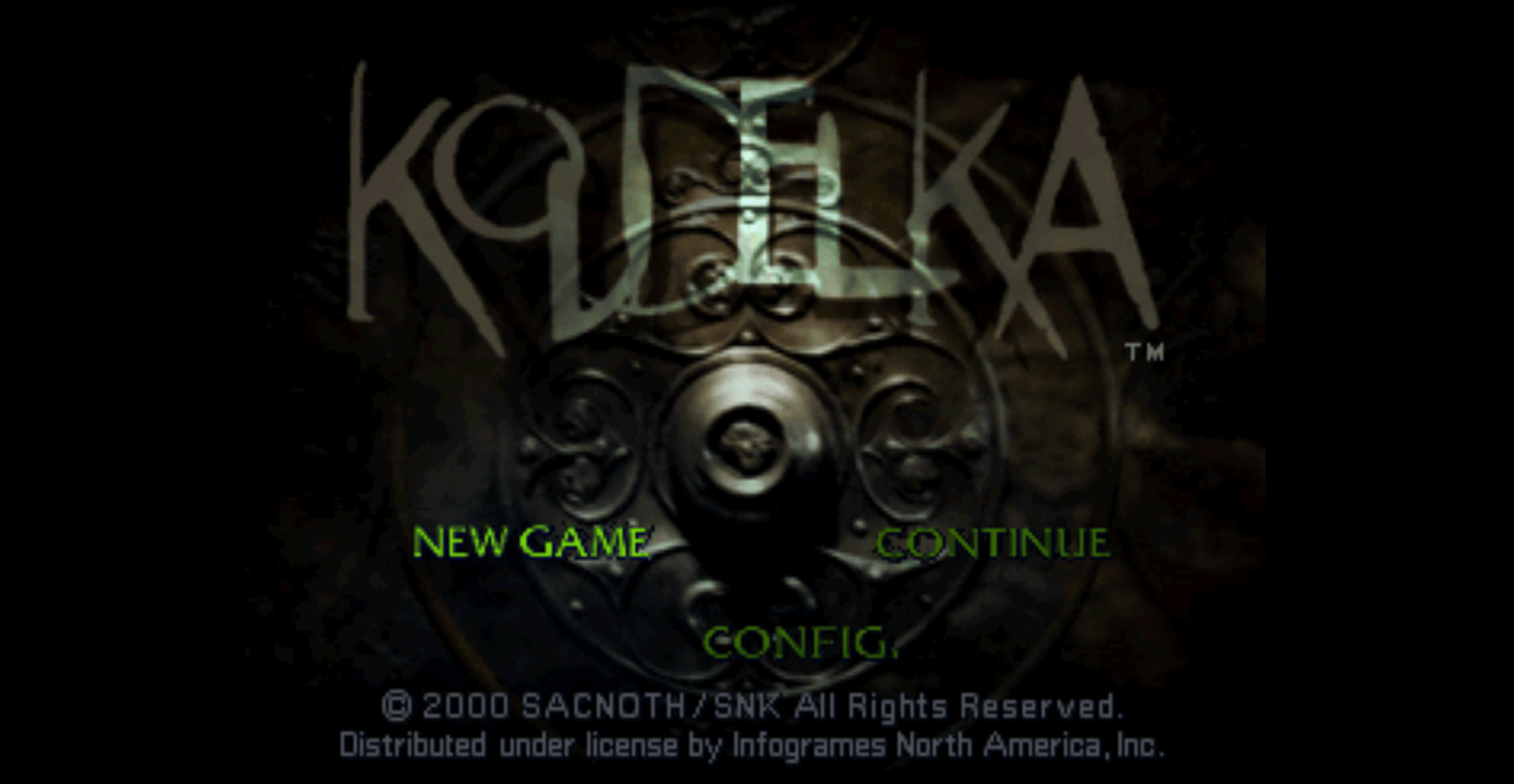Let’s be real. Koudelka won’t be for everyone. It is often tedious and requires a commitment to grinding that makes Pokémon look like NBA 2K. It is a game that has only ever been released on the original PlayStation, coming out in December of 1999 in Japan and throughout the summer of 2000 in the rest of the world.
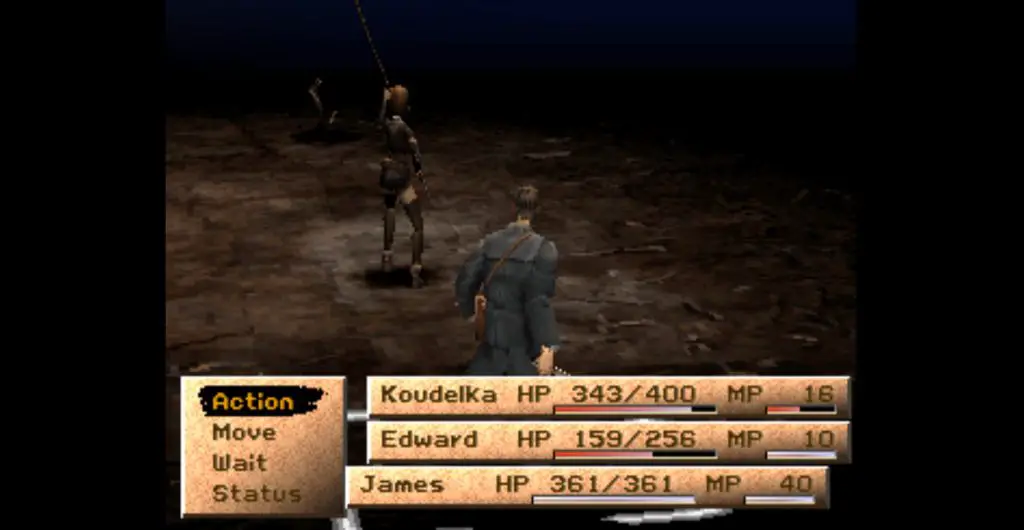
But it is turn-based survival horror. And serious collectors and those passionate about older video games can find working copies of both the English language and Japanese language releases on Ebay. The characters debate the poetry of Lord Byron. Koudelka is a tough-as-nails medium that is forced to navigate a haunted castle turned abandoned monastery or haunted monastery turned abandoned castle (plot details can be a bit sketchy throughout the game) alongside a very judgmental Catholic priest. And there is great music. And sound effects!
Koudelka’s Dark Tale
The game begins when the title character, Koudelka, enters a mysterious, old castle. She meets the second main character, Edward, in the opening sequence. It appears Edward has come to this house after hearing quite a few rumors about scandalous behavior that occurs within. He wants to put the fear of God in the inhabitants.
Unfortunately, demons get the better of him rather quickly. His luck turns for the better when Koudelka finds him and saves his life. Thus, the two wayward souls must begin their journey through this mansion fraught with floating chairs and diabolically severed limbs.
Turn-Based Horror with Grid-based Combat
Koudelka’s combat mechanics are fairly straightforward. But they are also refreshing in some ways. Characters aren’t locked into any particular build. They may start off pre-disposed to certain strengths and weaknesses, but the leveling process allows the player to develop their characters in whatever direction they choose. So any character can become good at magic, ranged attacks, close-up fighting, a jack of all trades, etc, etc.
The menus both in and out of combat are very straightforward and standard for the period. Players can choose to attack, use magic, move, or wait during each turn. There are spells that allow players to boost characters’ stats during a particular battle. Standard healing mechanics are also in place in and out of combat. Characters can use either items or spells to refresh their characters. And HP and MP pools are refilled every time a character levels up.
Combat takes place on a grid. The battle area seems to be standardized throughout the game, so no matter where your combat is taking place, the fighting will always be done on the same grid. So, where the player is on the map before combat takes place has no bearing on how the grid is laid out, different from a game like Final Fantasy Tactics.
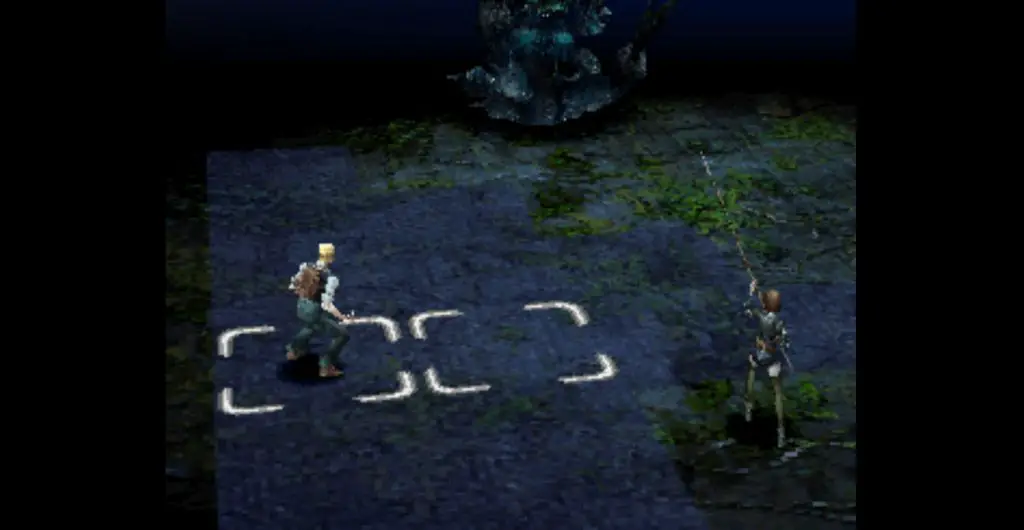
Enemies also have the ability to knock back player characters with their attacks. Because the battles happen on a dedicated grid, there isn’t the possibility of knocking a character off a ledge or cliff. But, characters positions on the grid are key to executing certain types of attacks. For example, characters who use a spear will need to leave one square between themselves and their target to be able to execute the attack. And while player characters generally have plenty of AP to move and attack at their leisure, the game at least boasts enough depth to its combat system to keep battles interesting and players engaged.
Players are also seemingly required to position their party in a way that avoids friendly fire. So if a character uses a pistol, the player will need to position the other characters in their party around the enemies in a way that allows the gunfire a clear path to the target without threatening the other party members. The game also features standard JRPG combat staples like poison and other negative status effects.
But regardless, players will have to use the combat grid to their advantage. Positioning your party is a critically important part of combat. Once your characters become strong enough, the party is able to muscle their way through the average encounter without much effort. But boss fights will require some planning and item management.
Character Progression and Customization
The level-up mechanics are fairly standard for a game of its time. The characters gain experience points and level up rather slowly. Each time a character levels up, the player is in charge of assigning a certain number of stat points to their character. There is no auto-level-up function. The stats are fairly standard as well, with the main options being strength, dexterity, ability, mind, intelligence, luck, etc, etc.
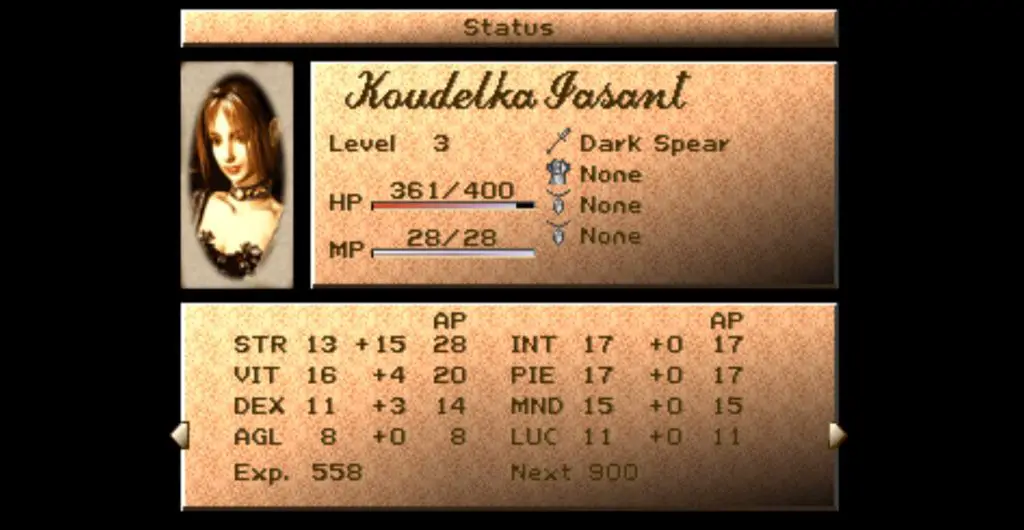
Players will also notice a function popular in action-oriented RPGs of this era, such as Dungeon Siege. The more a character uses a particular weapon type, the more proficiency they gain with said class of weapons. So if you give your priest, Paul, a pistol and make sure they consistently use it in combat, that character will level up their pistol ability throughout the game. It is not possible to level up your weapon skills outside of using the weapon in combat. Therefore, the character stats and weapon stats level up separately.
Atmosphere and Aesthetics
Perhaps Koudelka’s most profound appeal is bringing a party, turn-based combat system to classic PS1 survival horror aesthetics. The game immediately calls to mind the first Resident Evil game, as players have to navigate their way through a haunted monastery (or abandoned castle) and defeat a collection of sinister plants, haunted severed limbs and diabolical floating furniture. Some of the enemies even have fully formed bodies! And there are also giant plants, likely possessed by demons!
This is to say that while this game is far more gothic than Resident Evil, it can definitely appeal to players who want to immerse themselves in the visual and audio experience of a classic PS1 survival horror game without the stress and difficulty of live-action combat.
Challenges and Criticisms
The game is also more generous in its resources than a game like Resident Evil. While ammo is limited and melee weapons do break, a steady stream of everything the player needs is made readily available. There are certainly times when the player will feel the stress of needing to level up and heal, especially during a boss fight. Major combat sequences will drain you of your healing items, and you will run out of MP before the fight is over. But the boss fights also aren’t impossible. As long as you use your characters well and spend a bit of time grinding their levels up every now and then, you’ll be fine.
Koudelka save states are few and far between, reminiscent of other turn-of-the-century JRPGs like Suikoden 1 and 2. The player will occasionally find fountains of holy water that they are allowed to save the game at, often after they defeat a boss that allows the holy water to return to the previously derelict fountain. This is likely where players will experience the most difficulty. Unfortunately, this game places its save states largely after major conflicts, not before. So if you die during a boss fight, you will likely get sent back a bit further than you would prefer in the game.
This calls to mind the main conflict most players will likely have with Koudelka. It’s an extreme grind. There are conflicts roughly every 3-6 seconds when exploring the levels. This makes it somewhat difficult to get fully absorbed in the atmosphere of the game. And if you get lost, it makes finding your way again extremely tedious. The only benefit this ultimately has is that your characters end up getting plenty of experience points, whether you intend to grind them or not.
However, the frequency of combat is not the only potential issue players may face with this game. Some might find the plot to be a bit underwhelming. There is certainly potential in the characters and the overall storyline of the game. And it’s easy to see why this game spawned three sequels. But this game just does not have a character like Pilika from Suikoden 2 or Millium from the Legends of Heroes series.
That being said, this game shines in so many ways. The gothic atmosphere is perfect. Players who enjoy the dungeon synth genre of music will feel intimately at home in this game. Gamers who want more mature content will also enjoy this experience. Especially players who enjoy more academic or intellectual dialogue will find this game refreshing. This might even be the perfect time for a revival in interest in Koudelka, given the rise of the dark academia genre of literature.
Mid-tempo and lyrical ballads
The audio is one aspect of the game that truly shines. The sound of footsteps moving through the corridors recalls the click of boot heels from the first Parasite Eve. But the crackle of candlelight added in the background gives this game a gothic atmosphere that few of its time can boast. The original score of Koudelka is also excellent. Compositions range in tempo as one might expect of a game from this era. But both the mid-tempo and lyrical ballads throughout the game leave a lasting impression and make for excellent listening outside of the game.
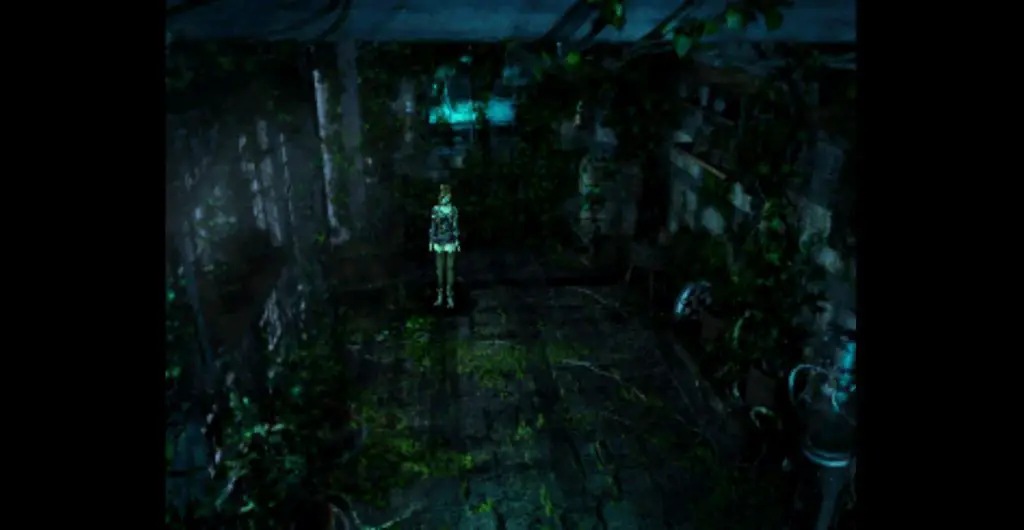
The voice acting also stands out and is memorable. Players will likely notice that the game is four disks long. This is somewhat deceptive without context. The game will take players between 10 and 20 hours. If you get lost a lot and have trouble successfully navigating the combat, expect your playthrough to lean closer to the 20-hour mark. But if you work through the game with a guide or just have a knack for these kinds of games, you can finish as quickly as 8.5-10 hours. Which is to say, the reason for four disks is audio. Lots and lots of audio. So what the game might lack in an emotional connection to its characters, it more than makes up for in atmosphere and audio nuance.
Visually the game will likely appeal to those who enjoy the period. It is much more reminiscent of the Squaresoft RPGs of its time than those released by Konami. Unfortunately, the graphics are not nearly as clean as something Squaresoft released at that time. But one might argue that Koudelka’s grainy, dirty visuals only enhance its gothic experience.
The overall experience of the game, outside of combat, is much like the first Parasite Eve as well. The camera angles are extremely similar. And items are spread across the map in a style similar to what one would find exploring the various levels in Parasite Eve. And while the game does offer a few party members, its cast of playable characters is much smaller than something like Suikoden or Final Fantasy.
Availability and Pricing in 2025
It’s also important to address what could also be the biggest issue players might have with this game; price and availability. This is not the easiest game in the world to find at a reasonable price. I myself got the four disks without a case at around 150 US dollars. The third disk had some difficulty being read, but a bit of Novus #2 got it buffed out and fully functional again.
The game’s price varies quite a bit. At the time of writing, an English language copy of this game is hard to find for under 250, which is an interesting double-edged sword. Given the chaotic financial environment we are in during the Spring of 2025, one could view a game like Koudelka as an interesting investment. Especially if you can get a copy of the working English language for less than 200 US dollars. The price has continued to rise throughout 2025, with copies being sold as high as 300 or 400 US dollars. Please note that Japanese language copies are much more affordable, but require both a Japanese PlayStation 1 and at least working fluency in written and spoken Japanese.
Final Thoughts
Overall, if you are a fan of JRPGs from the late 1990s and very early 2000, Koudelka is a game that can scratch a very particular itch. It offers high-quality turn-based combat and an excellent gothic atmosphere, especially when it comes to audio. The voice acting and music are both outstanding. There are lines of dialogue that make the game rather fun, especially for players who are familiar with certain schools of 19th-century poetry and theology.
And while the plot might feel a bit standard and underwhelming for some, there aren’t a lot of ultra gothic turn-based JRPGs out there. Especially from this era. If you’re into this kind of thing and are able to find an affordable copy, it is absolutely worth it, and if the game does sound appealing but you aren’t able to get your hands on a physical copy, there are a couple of high quality full playthrough streams of the game available on Youtube.
Regardless, if the game does sound appealing, it’s worth your time to experience in whatever way is best for you. There aren’t a lot of games like Koudelka, and it deserves far more attention than it’s received in the two and a half decades since its initial release.

